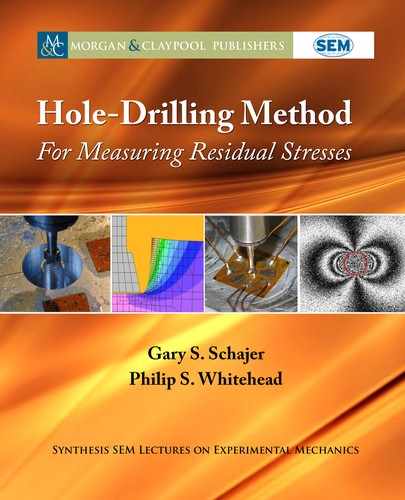
2.4. TWO-GROOVE METHOD 23
either side to release the residual stresses locally. e slots are made long and deep enough that
the residual stresses originally existing at the strain gauge location are almost entirely relieved.
A slot length > 4D and slot depth d > D is sufficient. In this way, the material attached to
the strain gauge is conceptually excised, even though not physically. Figure 2.2 illustrates the
process.
2D
d
2g
Stem
Groove
Groove
Strain Gauge
Figure 2.2: Schematic of Two-Groove Method (from Jullien and Gril (2007)).
e Two-Groove Method demonstrates fundamental characteristics that are typical of
relaxation methods in general:
1. e released residual stresses are those that originally acted on the plane of the cut surface.
ese are the specific residual stresses that are evaluated by the measurement method. In
the case of the Two-Groove Method, the main interest focuses on the normal in-plane
stress acting perpendicular to the slot direction. us, for effective use of the method, the
direction of the major in-plane residual stress must be known in advance so that the strain
gauge and slots can be aligned accordingly.
2. e shear stresses that originally acted on the plane of the cut surface are also released.
In the case of the Two-Groove Method, a perpendicular strain gauge such as shown in
Figure 2.2 would not detect the associated shear strains, so the desired measurement of the
normal stresses is not affected. If a shear stress evaluation is desired, a strain gauge aligned
at 45
ı
is required.

24 2. RELAXATION TYPE RESIDUAL STRESS MEASUREMENT METHODS
2.5 SPLITTING METHOD
e Splitting Method illustrated in Figure 2.3a has some geometric similarities to the Two-
Groove Method, but typically uses only a single slot. e measurement concept derives from
the deformations seen in material that has cracked due to excessive residual stresses, for example,
as shown in Figures 1.6, 1.13 and 1.14 in Chapter 1. A deep cut is sawn into a specimen such as in
Figure 2.3a and the opening or closing of the adjacent material indicates the sign and the average
size of the residual stresses present. An opening motion indicates perpendicular residual stresses
that are tensile on the outer surfaces and compressive in the interior, while closing indicates
the opposite. is method is convenient as a quick comparative test for quality control during
material production.
(a) (b) (c)
Figure 2.3: e splitting method, (a) for longitudinal stresses in rods, (b) for axial stresses in
wood (from Fuller (1995)), and (c) for circumferential stresses in tubes.
A similar material response can occur when sawing wood. As seen in Figure 1.13 in
Chapter 1, wood can contain significant residual stresses. In the case shown, these are “growth
stresses,” which are formed in the living tree to enhance its overall bending strength. Further
substantial residual stresses can be created during the wood drying process, especially when ac-
celerated by the use of drying kilns. Residual stress induced deformations can be problematic in
sawmills when cutting the dried wood. If the material motion happens to be inward, the wood
will close up on the sawblade during cutting, possibly quite tightly. Should the wood workpiece
not be secured sufficiently, the saw will grab the wood and throw it out from the machine at high
speed, creating a serious safety hazard. us, it is common to test for the presence of residual
stresses in kiln-dried lumber. is is done using the “prong” test illustrated in Figure 2.3b.
An interesting variation of the prong test involves using a specimen similar to that shown
in Figure 2.3a and to measure the lateral force required at the open end to maintain the original
spacing between the two cut sides. is use of a force measurement instead of a displacement
measurement is of interest because it gives a surface stress result that does not require explicit
knowledge of Young’s modulus. is feature is attractive when working with a natural material
..................Content has been hidden....................
You can't read the all page of ebook, please click here login for view all page.
